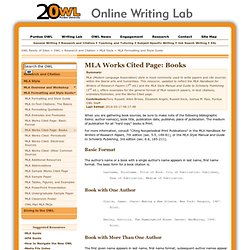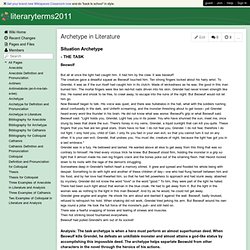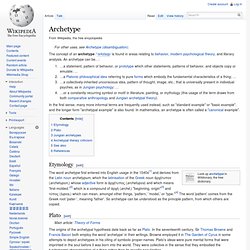

Exposition. MLA Formatting and Style Guide. Summary: MLA (Modern Language Association) style is most commonly used to write papers and cite sources within the liberal arts and humanities.

This resource, updated to reflect the MLA Handbook for Writers of Research Papers (7th ed.) and the MLA Style Manual and Guide to Scholarly Publishing (3rd ed.), offers examples for the general format of MLA research papers, in-text citations, endnotes/footnotes, and the Works Cited page. Contributors:Tony Russell, Allen Brizee, Elizabeth Angeli, Russell Keck, Joshua M. Paiz, Purdue OWL StaffLast Edited: 2014-03-17 08:17:48 When you are gathering book sources, be sure to make note of the following bibliographic items: author name(s), book title, publication date, publisher, place of publication. For more information, consult “Citing Nonperiodical Print Publications” in the MLA Handbook for Writers of Research Papers, 7th edition (sec. 5.5, 148-81), or the MLA Style Manual and Guide to Scholarly Publishing, 3rd edition (sec. 6.6, 185-211).
Literaryterms2011 - Archetype in Literature. Beowolf But all at once the light had caught him.

It had him by the claw. It was beowulf! The creature gave a dreadful squeal as Beowulf touched him. Ten strong fingers locked about his hairy wrist. Analysis: The task archetype is when a hero must perform an almost superhuman deed. Archetype Characters- The CharactersThe HeroA hero is not someone who is only brave or noble to his/her subjects, but willing to be a self-sacrifice. Literaryterms2011 - Three Examples of Catharsis. Connects Synonyms, Connects Antonyms. Archetypes in Literature. Examples of Archetypes, Literature© Deborah Rudd Guerin, Wilfred L., et al.

"Mythological and Archetypal Approaches. " A Handbook of Critical Approaches toLiterature. NY: Harper & Row, 1979: 157-161. Guerin et al.states that archetypes are universal symbols, motifs or themes that may be found among many different cultures. Carry the same or very similar meanings for a large portion, if not all, of mankind . . . . certain symbols, such as the sky father and earth mother, light, blood, up-down, and others recur again and again in cultures so remote from one another in space and time that there is no likelihood of any historical influence and causal connection among them. (157) Water: birth-death-resurrection; creation; purification and redemption; fertility and growth.
Sea/ocean: the mother of all life; spiritual mystery; death and/or rebirth; timelessness and eternity. Rivers: death and rebirth (baptism); the flowing of time into eternity; transitional phases of the life cycle. . . . Archetype. The concept of an archetype /ˈɑrkɪtaɪp/ is found in areas relating to behavior, modern psychological theory, and literary analysis.

An archetype can be…: …a statement, pattern of behavior, or prototype which other statements, patterns of behavior, and objects copy or emulate; ……a Platonic philosophical idea referring to pure forms which embody the fundamental characteristics of a thing; ……a collectively-inherited unconscious idea, pattern of thought, image, etc., that is universally present in individual psyches, as in Jungian psychology; ……or a constantly recurring symbol or motif in literature, painting, or mythology (this usage of the term draws from both comparative anthropology and Jungian archetypal theory). Etymology[edit] Plato[edit] The origins of the archetypal hypothesis date back as far as Plato.
Jungian archetypes[edit] Archetypal literary criticism[edit] Verisimilitude. Verisimilitude is described as the quality of appearing to be true or depicting reality.

In storytelling, the audience contributes to the experience by their "willing suspension of disbelief". The more the story resembles reality -- even in small details -- the easier it is for the audience to engage. Realism and plausibility are especially important ingredients in an alternate reality game (ARG). Storytellers use many tricks to achieve this effect: References to popular culture References to other works of art, music, or literature Naturalistic dialogue (speakers interrupting each other, mumbling, losing their train of thought, etc.)
Art with no verisimilitude is criticized as being "stagey", "mannered", "fanciful", "false", "surreal", or just plain "bad". In some postmodern works of art, the artist intentionally draws attention to the lack of reality. The standards of verisimilitude constantly change with audience tastes and cultural trends. In Lost. What are examples of style in literature. Example of style in literature. TONE and MOOD are two different concepts in literature.